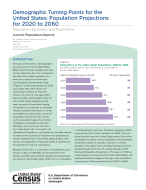Demographic Turning Points for the United States: Population Projections for 2020 to 2060
Demographic Turning Points for the United States: Population Projections for 2020 to 2060
Introduction
The year 2030 marks a demographic turning point for the United States. Beginning that year, all baby boomers will be older than 65 years of age. This will expand the size of the older population so that one in every five Americans is projected to be of retirement age. Later that decade, by 2034, we project that older adults will outnumber children for the first time in U.S. history. The year 2030 marks another demographic first for the United States. That year, because of population aging, immigration is projected to overtake natural increase (the excess of births over deaths) as the primary driver of population growth for the country.
Beyond 2030, the U.S. population is projected to grow slowly, age considerably, and become more racially and ethnically diverse. Despite slowing population growth, particularly after 2030, the U.S. population is still expected to grow by 79 million people by 2060, crossing the 400 million threshold in 2058.
This report discusses projected changes in the U.S. population and summarizes results from the U.S. Census Bureau’s 2017 National Population Projections. It focuses on 2030 as a demographic turning point for the United States, but explores broader changes in the age, race, and ethnic composition of the population from 2020 to 2060.
Others in Series
Publication
Publication
Publication




